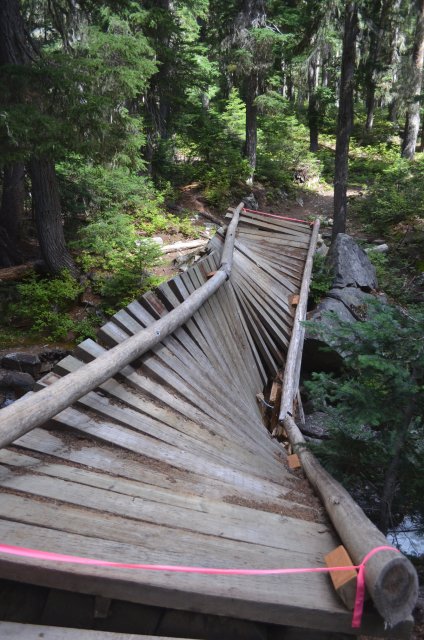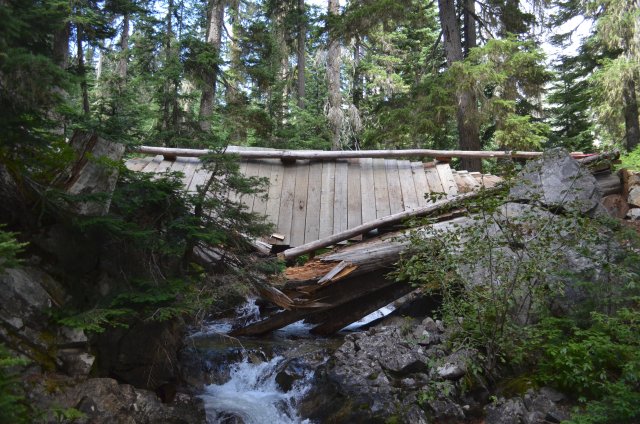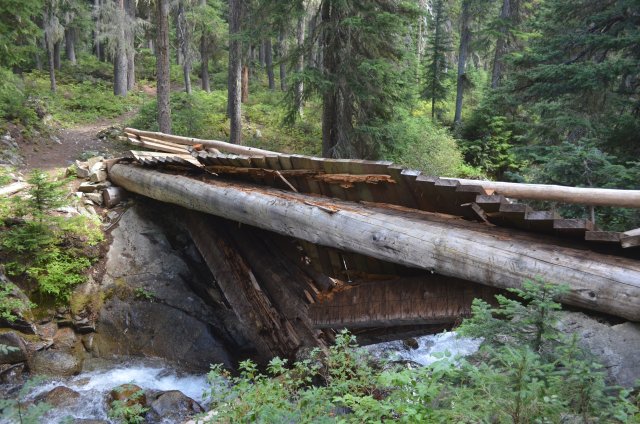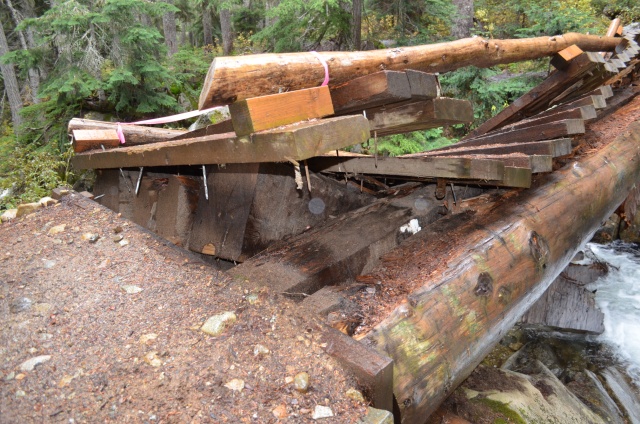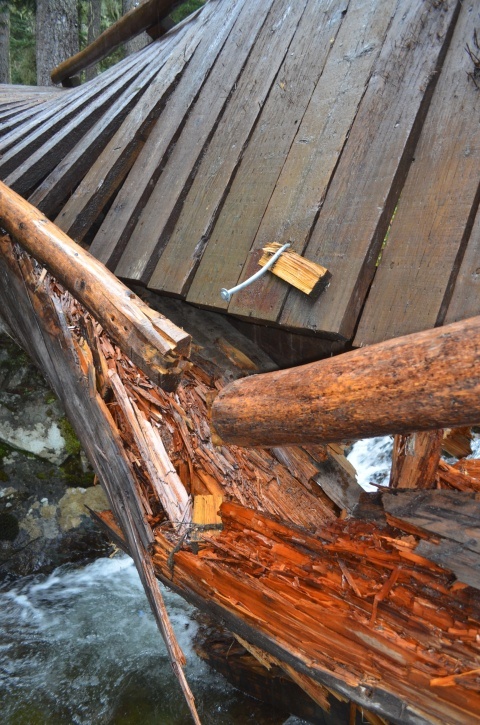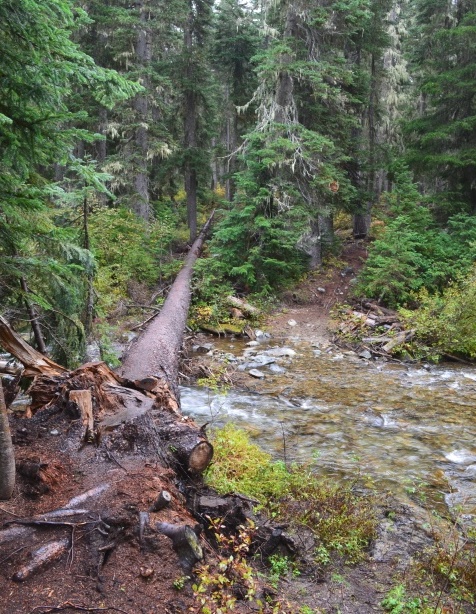Notice: The calculations on this page were neither calculated nor certified by a licensed engineer. All calculations for discussion purposes only.
Built:
Length:34ft
Type:Log Beam
Location: Bridge Creek,Wenatchee National Forest[1], Washington State
Reason for listing: Structural failure of major support member.
Author's Note: The forest service is required to construct and maintain numerous foot bridges in remote locations with a minimal budget. They do not have the resources to build and monitor bridges in the same way as the various departments of transportation do. Major contributing factors in this bridge failure are likely the remote location, limited materials for construction, and a lack of Forest Service resources.
This bridge was located during hike on the Pacific Crest Trail, south of the North Cascades Highway. Being a popular trail there are footbridges across many of the larger creeks. This is especially useful during the spring snow melt. Sadly, this foot bridge came to an unfortunate end.
A proper engineering analysis of the failure is not available. Rot was clearly a factor in the collapse, but snow load is another serious consideration.
Bridge Strength
While rot clearly caused the failure, it is worth considering how much leeway the original design had to allow for rot. Given how heavily built the bridge is, it would appear that it should have been able to handle a large load even when partly rotten.
Given the local weather, it is almost certain that snow load will dominate the design. This area is notorious for heavy snowfall, which results in the nearby highway 20 being closed during winter. Examples of the snow can be seen in the WSDOT photo collection from clearing the snow in the spring of 2013. Note that the snow in the photographs is compacted, not fresh. Also, WSDOT does not start clearing the highway until after the snow starts melting, so those photos do not show the peak depth. The foot bridge is about a mile south of the highway, between Washington Pass and Rainy Pass.
The nearby Rainy Pass NRCS/NWCC weather station [2] indicates a 2012 water equivalent snow depth of 55 inches! The high depth is due to moisture from the Pacific coming from the west, hitting the Cascade Mountains, and precipitating. Rainy Pass is on the divide, while the footbridge is a little east of the divide and slightly lower elevation. Both these factors suggest a slightly lower snow pack for Bridge Creek. However, local snow packs can vary tremendously due to microclimatic effects. For example, it is possible that the gap in the trees due to Bridge Creek could cause a substantial drifting effect, increasing the snow load on the bridge. Or maybe the bridge is in the rain shadow of a nearby mountain, slightly decreasing the snow load. Without detailed weather monitoring of the site there is no way to know. For calculations, 50 water equivalent inches of snow load will be assumed as the maximum, under the assumption that the maximum snow at the bridge is similar to the normal snow depth at Rainy Pass. Depending on actual conditions the necessary bridge strength could be much higher or lower.
Calculation Method
This calculation is based on the Allowable Stress Design (ASD) for wooden structures as described in Structural Design in Wood[3]. A note such as (p7) indicates what page of this book the information was found on. For general information on ASD please refer to a proper engineering reference.
Units: For measurements related to a given bridge units local to that bridge are used. Since ASD calculations in the US are normally performed in United States Customary Units those units are used here - despite the authors opinion that they should have been taken out and shot long ago.
Bridge Specifications and Assumptions[4]:
This calculation was done prior to taking proper measurements, so estimated values are used. A revised calculation with the actual measurements follows this calculation.
| Specifications & Assumptions: |
Justification |
| Beams are local timber |
They appear to be locally cut logs, and no other information is available. |
| Length: 34ft (408in) |
As measured. |
| Width: 6.4ft (77in) |
As measured. |
| 5 Main support beams. |
See photos |
| Calculations are done for an equivalent square beam. |
A log with a diameter equal to the width of the square can be assumed to be equivalent (p103). |
| Only bending force (F'b) is considered. |
The observed failure appears to have been due to an excessive bending moment. |
Bridge Load (l):
| Calculation |
Notes |
Find the unit weight of the wood (lbs/ft3):
wu = 62.4 lbs/ft3 (G)(1 + MC/100)
- 62.4 lbs/ft3 is the specific gravity of water
- G is the dry specific gravity of the specific species of wood being use. G=0.5 as per Table C-1 (p420).
- MC is the moisture content of the wood. MC=26.9%
|
Start by finding the weight per ft3, including moisture content. The equation used is an approximation which allows us to ignore volume changes due to water absorbition, and will give a conservative estimate of self weight. (p45)
Moisture content indicated is highest given on Table 2-4, p19. Actual content could be higher depending on how waterlogged the wood is due to the snow and creek. |
ws = 62.4 lbs/ft3 (0.5) (1 + 26.9 / 100)
ws = 40 lbs/ft3 |
|
| 1.5ft cross section for main beam gives 2.25 ft3 per beam. |
To estimate the weight of the wood the volume is needed. While the beams are generally round, they are also not uniformly 18in diameter. A volume equivalent to a square cross section is assumed. |
| x5 for 5 beams = 11.25 ft3 per foot of bridge. |
Always keep track of load calculated per foot of bridge vs load per foot of 1 support beam. |
| Assume 0.2ft decking thickness. This adds another (0.2ft*6.4ft*1ft=1.28ft3) of wood volume per foot of bridge. |
Don't forget to count the weight of the decking, etc. |
| Add an additional estimated volume of 0.3 ft3 for the side rails.
|
| Total wood volume is 12.83 ft3 per foot of bridge.
| |
Is = 40 lbs / ft3 * 12.83ft2
Is = 513.2 lbs/ft |
Is , Moment due to self weight per foot of bridge. Will be used in later bending calculations. |
| Total self weight: 513.2 lbs/ft * 34ft = 17450lbs |
Note the importance of including self weight. |
| ls, snow load, = Mass of water[5] * width * depth |
Now to find the snow load. Since the snow depth is given in water equivalent inches the snow load can be found by finding the weight of that depth of water. |
| Water mass is 62.4lb/ft3 |
|
| ls = 62.4lb/ft3 * 6.4ft * 4.17ft = 1665lbs/ft |
Snow load per foot of bridge. |
| Total snow load: 1665lbs/ft * 34ft = 56610lbs |
|
| I, total moment per unit length, = 513.2lbs/ft + 1665lbs/ft = 2178lbs/ft |
|
| Total load: 17450lbs + 56610lbs = 74,060. |
Snow load plus self weight. |
This is a remarkable load for a simple foot bridge, and an example of the need to consider snow loads.
Maximum Moment on Beam (M):
Calculated for a uniform load across the length of the beam.
| M = (weight)(length2)/8 |
Equation for the moment on a uniformly loaded beam. |
| M = (2178lbs/ft)(34ft)2/8 |
|
| M = 314,721ft*lbs |
|
| Divide by 5 beams: 62,944ft*lbs (755,330in*lbs) |
|
Adjustment Factors (p61)
The adjustment factors are strength multipliers that either increase or decrease the allowable load depending on how the support beam is used.
| CD, Load Duration Factor: Snow Load = 1.15 |
The duration of a load has a large impact on how well wood can handle it. The longer the duration the more wood will be affected by creep. |
| CF, Size Factor: (12in/18in)1/9 = 0.956 |
Larger beams have a reduced allowable load due to the increased occurrence of unknown internal defects (p61) |
| CL, Beam Stability Factor: 1, for round or square beams |
Were this a narrow & tall beam it would have a reduced strength to lateral instability - but round beams are stable.. |
| CM, Wet Service Factor: 1.00 |
Oddly, the wet service factor is 1.00 for Douglas fir timbers, which are defined as beams 5in X 5in or larger (p398). Smaller lumber is given a wet service factor of 0.85, but only for the higher grades of lumber. It is odd to think that the extreme humidity of the location is not considered to have a direct impact on the strength of the wood. But there still is the increased weight due to waterlogging, as well as increased rot. |
Wood Properties
Assume that the main support beams are local lumber. The local trees are either Sikta Spruce or Douglas fir
[6]. Douglas Fir will be assumed.
- Given the local collection of wood from ungraded sources, grade No. 2 will be assumed.
- Fb, Bending resistance, 875psi (p396)
Necessary Beam Size
| , Required section modulus, = M/F'b |
The section modulus is a measure of a beams strength. Finding the required section modulus will allow determining what size of beam is necessary to carry the calculated load. |
| F'b = Fb * CD |
F'b is the allowable stress the wood can handle, including applicable adjustment factors. |
| F'b = 875psi * 1.15 * 0.956 |
|
| F'b = 962psi |
|
| S = 755,330in*lbs / (962lb/in2) |
|
| S = 785in3 |
|
The section modulus of a uniform rectangular beam is s=bs2/6 [7]. This gives s = 18in(18in)2/6 = 972in3, leaving each beam of the bridge with 187in3 of section modulus to spare.
Conclusions
The logs selected were slightly over strength before they start rotting. Rot will slowly eat away the safety factor, resulting in an eventual collapse as seen above. Obvious solutions include the use of a substantially larger timber, treated wood, bringing in some other support beam, or telling the hikers to wade the creek. Note that creek temperature and depth, especially during the spring melt, should be considered prior to wading.
Complicating Factors
Numerous factors were not considered in these calculations but could have a major impact on the final result. Here are some of them:
- The five support beams were not identical.
- Given the depths involved the bridge is actually buried in a snow bank. There could be some support from the surrounding snow, especially if the area under the bridge becomes filled with snow & ice. Alternatively, snow hanging on either side might provide some additional load.
- The lumber used is not cut, while the calculations treat it as cut. Logs can have substantially different characteristics from cut lumbar because the trees grow to accommodate any defects. Also, it does not appear to be farmed lumber, and could be old growth. It is very possible that the wood would have, prior to rotting, provide superior performance than the No. 2 rating assumed.
- The long duration of the winter snow pack could change CD
- Every winter water regularly freezes inside the wood. Any effect this might cause is not considered.
The Forest Service rerouted the trail across a nearby fallen log, which now serves as the replacement bridge. For readers that do not spend much time hiking, fallen logs are often used as bridges when hiking in the wilderness. They can work quite well. One nice part of this solution is that the reduced area of the log results in a substantially lower snow load. The drawback is that it also makes it easier for hikers to fall off the bridge. Also note that horses, or adventurous hikers, can wade the creek to the right of the log
In early October 2013 snow is falling on the nearby Early Winters Spires. In about a month even the tenacious Washington State Department of Transportation will retreat from the freezing onslaught. And as the last few hikers of the season use the foot log to cross the river the Forest Service is paralyzed by ongoing government shutdown [8]. Maybe they will one day replace this bridge, but not any time soon. Or maybe over time more and more of the National Forest's bridges collapse, and only ad hoc solutions will remain - if the trails don't become disused altogether.
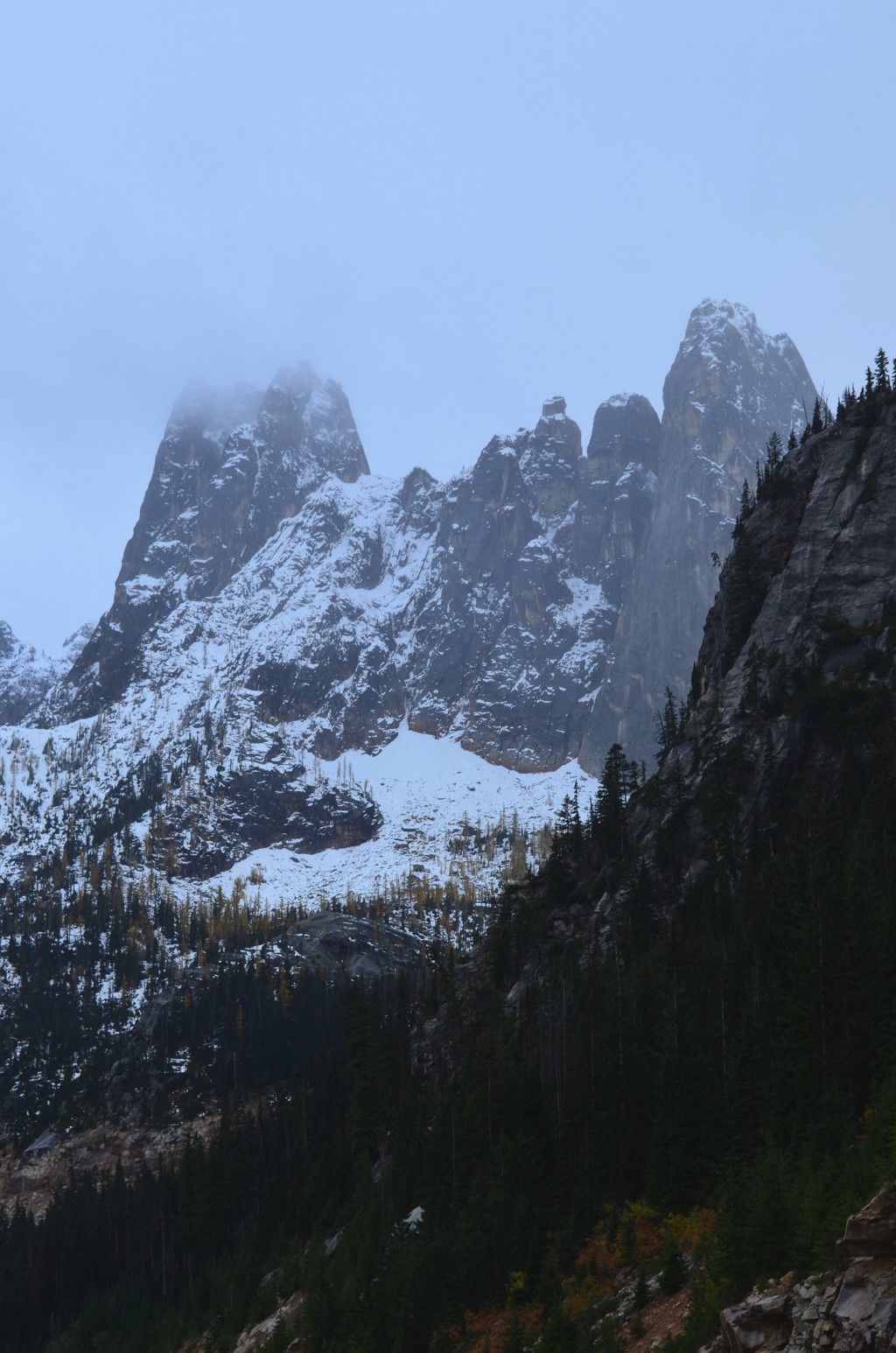
Notes:
1) While this area is administrated by the Okanogan National Forest, it is officially part of the Wenatchee National Forest.
2) Data retrieved from Natural Resource Conservation Service (NRCS) webpage. Rainy Pass station data for the 2012 water year was used.
3) All calculations based on Structural Design in Wood (2nd edu) by Judith J. Stalnaker and Ernest C. Harris. ISBN 0-412-10631-0. Errors in calculations should be assumed be due to the author misunderstanding the calculation, unless proven to be due to something else.
4) Exact measurements were not available when this issue was first posted. Measurements were later taken, and an additional calculation posted. The difference between the two emphasize the need for proper measurements before any calculations can be taken seriously.
5) Mass of water is used since the snow data reports water equivalent inches, or how many inches of water the snow would produce if melted.
6) Sufficient details to identify the tree type were not gathered. If opportunity arises, they will later be identified. The main reason for assuming Douglas Fir was that the reference book does not provide values for Sitka Spruce, although such values are undoubtedly available elsewhere.
7) Section modulus equation given by Wikipedia.
8) The 2nd batch of photographs was taken during the 2013 US Government Shutdown. Most Pacific Crest Trail hikers were stopped by an early blizzard or the closure of North Cascades National Park. However, a few were still making it through in early October.
Last Update: May 2019. Fixed typo.
© David C. Hunter, 2013
fb {at) scarybridges (dot] com


